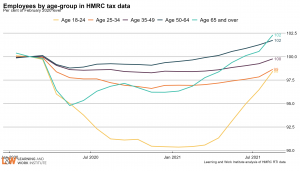September 2021
1. The labour market continues to recover with payroll employment back at pre pandemic levels
Employment rose by 183,000 in May to July 2021 compared to the previous quarter but is 716,000 lower than before the pandemic. The timelier measure of PAYE employees increased by 241,000 in August 2021 compared to the previous month.
Unemployment is up by 186,000 from before the pandemic, falling by 86,000 in May to July 2021 from the previous quarter.
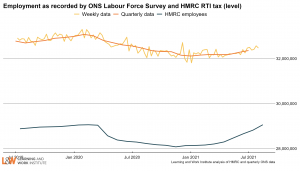
2. The number of people claiming benefits remains worryingly high
The number of people claiming unemployment-related benefits fell by 58,600 in August 2021 compared to the previous month, meaning the number of people claiming benefits both in and out of work now stands at 2.19 million.
This is decreasing but not as significantly as expected and claimant unemployment remains higher than the survey measure of unemployment – historically, claimant unemployment has usually been lower. This is likely to reflect decisions made in the pandemic to keep benefit claims open for longer in case people’s circumstances change or other reasons.

3. Significant numbers of people remained furloughed ahead of the scheme’s closure
Substantial numbers of workers remain on furlough, which ends in just over two weeks. At the end of July 2021, the total number of people furloughed stood at 1.56 million, of whom 820,000 were fully furloughed.
The rate at which numbers are reducing is shrinking each month – in June the fall was 624,000, while the fall in July was 338,000.
Survey data suggests the number of people furloughed continued to fall during the summer but may still stand at around one million.
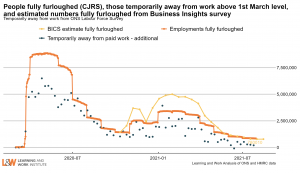
4. Long-term unemployment has risen substantially
The longer someone is out of work, the less likely they are to find work. Long-term unemployment can have damaging impacts on people’s career prospects, particularly for young people, as well as on health and wellbeing.
The number of people aged 25 and over who are long-term unemployed, defined as out of work 12 months or more, has risen 109,000 (46%) since the pandemic started (Dec 19-Feb 20). Youth long-term unemployment (defined as six months or more out of work) is up 47,000 (32%) since the pandemic began.
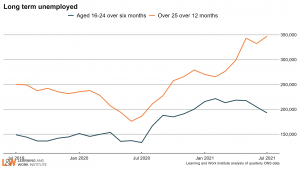
In the October Spending Review, the Government needs to maintain and extend its Plan for Jobs to limit the number of people becoming long-term unemployed and support those who are long-term unemployed to find work.
5. Employment for young people was hardest hit, with participation in education rising
Employment for young people is recovering, although they continue to have seen the biggest drop in payroll employment across the pandemic. Young people account for 39% of the fall in employment, despite accounting for just 12% of total employment. As a result, the number of unemployed 16-24 year olds has risen 11,000 since the last pre-pandemic figure and 391,300 18-24 year olds are claiming unemployment-related benefits, 66% up on pre-crisis levels.
A Youth Guarantee is needed to ensure that all young people get the help they need to move into work through investment in employment support, education, training and jobs.

The percentage of 18-24 year olds in full time education has risen from 31.7% in June 2020 to 35.8% in July 2021. In turn, figures for those not in full time education have declined. Many young people have sheltered from the stormy labour market by moving into full time education – this makes sense and, provided they are in high quality education that suits them, can help to narrow our education gaps with other countries.
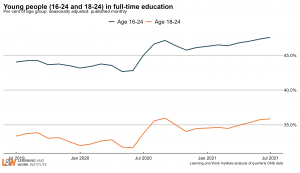
6. We need to avoid a long-term unemployment crisis for older workers
While payroll employment is back to pre-pandemic levels for older people, those over 55 years old make up 23% of furloughed workers now, compared with 10% of under 25s. L&W research finds that older workers who lose their jobs are far more likely become long-term unemployed. Just one in three (35%) of over 50s who lose their job return to work quickly, compared to two in three (63%) workers aged 25 – 34. It is therefore essential that targeted help is provided to older people, including those who remain on furlough and become unemployed at the end of this month.
